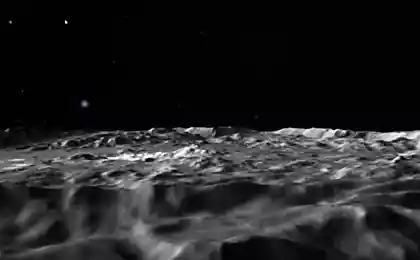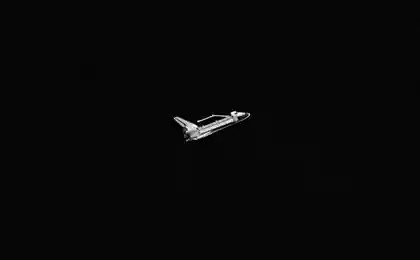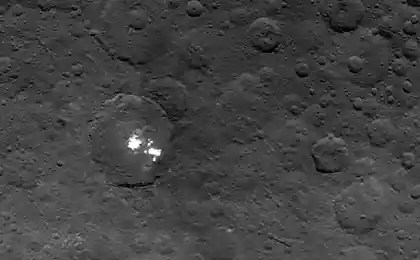631
The end of the main probe Dawn mission. The device remains in Ceres forever

July 1 main mission Dawn probe is over. NASA is not going to shut down the unit, how it plans to deal with the interplanetary station Rosetta ESA. But further Ceres Dawn will not fly as expected. Previously, the project team planned that the probe after studying the planetoid Ceres fly farther - first to the sun, going to secure for themselves the orbit, and then the asteroid Adeona. Last point of the plan was designed to May 2019.
But now, experts have come to the conclusion that the study should continue Ceres - the scientific value of the current mission will be higher than a visit Adeona. Scientists believe that Dawn could get interesting for science data during the passage of the planetoid through perihelion - the minimum distance from the Sun point of the orbit. The project team could not come to a consensus in terms of extending the probe mission. July 1 at NASA has even appeared a post with information about the Dawn mission to Ceres. Later the post was removed, and the representatives of the agencies said that the publication of this material was a mistake. Now the site contains information that the probe is in orbit of Ceres.

Photo spots on Ceres, Dawn sent in March 2016 (Photo: NASA)
Long road to Ceres
History Dawn probe began in 1992, when the leading expert of the project, Christopher Russell (Christopher Russell) presented the efficient ion engines machine. They can not develop such a significant thrust as rocket engines, but operate much longer. Such engines originally planned to be installed on the artificial earth satellites, but Russell decided to put them on the machine, which will go to the asteroid belt of the solar system.
Authors of the project received three non-NASA leadership, but in 2001 the mission has been approved yet. As part of the probe Dawn mission it was to visit two of the largest objects of the asteroid belt: Vesta, the largest asteroid in the solar system, and Ceres, a dwarf planet. According to Russell, the use of chemical rocket engines to Vesta and Ceres would have needed to run two machines - the fuel just would not be enough to visit once the two objects in the asteroid belt. But as the project team decided to use ion engines, the whole program could be carried out using only one device.
Why choose to study decided to Vesta and Ceres? The fact is that scientists have considered them the oldest objects in the solar system. Their study could help to clarify some aspects of the origin of planets and find out what processes led to the formation of the solar system in its current form. In this case the two objects are different from each other. Vesta - a rocky world without a large amount of liquid or gas. The surface of Vesta is covered with impact craters. Ceres is different from Vesta lower density previously been suggested that the surface can be covered with ice, and beneath the surface may be hiding an ocean of liquid water. In addition, on the surface of Ceres, astronomers have noticed mysterious bright spots. But the earth was impossible to understand what kind of education, and what is their nature. Ceres - the only object in the solar system with these properties.
Success Dawn
mission Probe launched into space in 2007. Output device beyond the Earth has been carried out with the help of the carrier rocket Delta II. For Vesta unit approached in 2011.

Anthony Crater (southern hemisphere of Vesta). Photo: NASA
Having stayed on the asteroid's orbit year, the probe went to Ceres. He was released in March 2015 on the orbit of the planetoid Dawn. In October 2015 the spacecraft took the lowest orbit.
As planetoid closer to Earth, scientists are becoming more and more high-quality images of Ceres and its surface. But the nature of the spots found out only after the closest approach to the planetoid. Up to this point a group of scientists speculated that the spot - it's the output of water ice on the surface. Other experts argued that this salt outcrop.
After the probe sent the last data study spots with high-resolution photos of these formations, the situation became clearer. Likely spots consist of magnesium sulfate, chemical compounds with a high albedo. By the way, not so long ago, scientists saw haze over these spots.
The researchers found that under the surface of the planetoid are large deposits of water ice. Scientists say that in the early stages of the evolution of Ceres was warmer world, and on the surface of the ocean lapped. Unfortunately, the world began to cool over time. And because of its own heat source (as in Europe, for example) have not been the planetoid, the water froze.
What's next?
Dawn probe will continue to explore the planetoid while in its orbit. Questions about the origin of Ceres, on the structure of its surface layers and subsoil more questions than answers. And scientists are hoping to get answers to at least some of these questions.
Source: geektimes.ru/post/278034/























